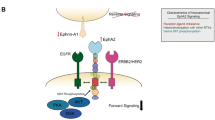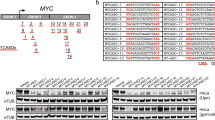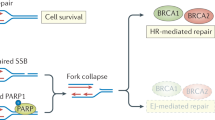Abstract
Substantial evidence exists supporting a direct role for raf kinases in the development and maintenance of certain human malignancies. Here we test the potential of phosphorothioate antisense oligodeoxynucleotides targeted against human C–raf–1 kinase to specifically inhibit C–raf–1 kinase gene expression and tumor progression in cell culture and in vivo, using human tumor xenograft mouse models. Treatment of human tumor cells with appropriate phosphorothioate antisense oligodeoxynucleotides led to specific inhibition of C–raf kinase gene expression in cell culture and in vivo at well–tolerated doses. Moreover, oligodeoxynucleotide treatment resulted in potent antiproliferative effects in cell culture and potent antitumor effects in vivo against a variety of tumor types that were highly consistent with an antisense mechanism of action for these compounds. These studies strongly suggest that antisense inhibitors targeted against C–raf–1 kinase may be of considerable value as antineoplastic agents that display activity against a wide spectrum of tumor types at well–tolerated doses.
This is a preview of subscription content, access via your institution
Access options
Subscribe to this journal
Receive 12 print issues and online access
$209.00 per year
only $17.42 per issue
Buy this article
- Purchase on Springer Link
- Instant access to full article PDF
Prices may be subject to local taxes which are calculated during checkout
Similar content being viewed by others
References
Daum, G. et al. The ins and cuts of Raf kinases. Trends Biol. Sci. 19, 474–480 (1994).
Nishida, E. & Gotoh, Y. The MAP kinase cascade is essential for diverse signal transduction pathways. Trends Biol. Sci. 18, 128–131 (1993).
Vojtek, A.B., Hollenberg, S.M. & Cooper, J.A. Mammalian ras interacts directly with the serine/threonine kinase raf. Cell 74, 205–214 (1993).
Zhang, X.F. et al. Normal and oncogenic p21ras proteins bind to the amino-terminal regulatory domain of c-raf-1. Nature 364, 308–313 (1993).
Warne, P.E., Viciana, P.R. & Downward, J. Direct interaction of ras and the amino-terminal region of raf-1 in vitro. Nature 364, 352–355 (1993).
Fabian, J.R., Vojtek, A.B., Cooper, J.A. & Morrison, D.K. A single amino acid change in raf-1 inhibits ras binding and alters raf-1 function. Proc. Natl. Acad. Sci. USA 91, 5982–5986 (1984).
Bos, J.L. The ras gene family and human carcinogenesis. Mutat. Res. 195, 255–271 (1988).
Bos, J.L. ras oncogenes in human cancer: A review. Cancer Res. 49, 4682–4689 (1989).
Rapp, U.R. et al. Structure and biological activity of v-raf, a unique oncogene transduced by a retrovirus. Proc. Natl. Acad. Sci. USA 80, 4218–4222 (1983).
Heidecker, G. et al. Mutational activation of C-raf-1 and definition of the minimal transforming sequence. Mol Cell. Biol. 10, 2503–2512 (1990).
Stanton, V.P., Jr. & Cooper, G.M. Activation of human raf transforming genes by deletion of normal amino-terminal coding sequences. Mol. Cell. Biol. 7, 1171–1179 (1987).
Fabian, J.R., Daar, I.O. & Morrison, D.K. Critical tyrosine residues regulate the enzymatic and biological activity of raf-1 kinase. Mol. Cell. Biol. 13, 7170–7179 (1993).
Shimizu, K. et al. Molecular cloning of an activated human oncogene, homologous to v-raf, from primary stomach cancer. Proc. Natl. Acad. Sci. USA 82, 5641–5645 (1985).
Fukui, M. et al. Detection of a raf-related and two other transforming DNA sequences in human tumors maintained in nude mice. Proc. Natl. Acad. Sci. USA 81, 5954–5958 (1985).
Rapp, U.R. et al. Role of raf oncogenes in lung carcinogenesis. Proc. from the Intl. Conf. on Hormones, Growth Factors and Oncogenes in Pulmonary Carcinoma (ed. Dunbar, B.S.) 122–137 (Plenum, London, 1987).
Rapp, U.R., Cleveland, J.L. & Storm, S.M. Oncogenes: Clinical Relevance. in Proceedings from Modern Trends in Leukemia VII: Hematology and Blood Transfusion. (eds. Neth, R., Gallo, R., Greaves, M.F. & Vanka, G.) 69–77 (Springer, Berlin, 1987).
Rapp, U.R., Cleveland, J.L., Bonner, T.I. & Storm, S.M. The raf oncogenes. in The Oncogene Handbook. (eds. Reddy, E.P., Skalka, A.M. & Curran, T.) 213–251 (Elsevier Science Publ., Amsterdam, 1988).
Wagner, R.W. The state of the art in antisense research. Nature Med. 1, 1116–1118 (1995).
Stein, C.A. Does antisense exist? Nature Med. 1, 1119–1121 (1995).
Crooke, S.T. Therapeutic applications of oligonucleotides. Annu. Rev. Pharmacol. Toxicol. 32, 329–376 (1993).
Monia, B.P. et al. Evaluation of 2′ modified oligonucleotides containing 2′-deoxy gaps as antisense inhibitors of gene expression. J. Biol. Chem. 268, 14514–14522 (1993).
Bennett, C.F. et al. Cationic lipids enhance cellular uptake and activity of phosphorothioate antisense oligonucleotides. Mol. Pharmacol. 41, 1023–1033 (1992).
Monia, B.P. et al. Selective inhibition of mutant Ha-ras mRNA expression by antisense oligonucleotides. J. Biol. Chem. 267, 19954–19962 (1992).
Crooke, R.M., Graham, M.J., Cooke, M.E. & Crooke, S.T. In vitro pharmacokinetics of phosphorothioate antisense oligonucleotides. J. Pharmacol. Exp. Ther. 275, 462–473 (1995).
Crooke, S.T. et al. Pharmacokinetic properties of several novel oligonucleotide analogues in mice. J. Pharmacol. Exp. Ther. (in the press).
Hoke, G. et al. Effects of phosphorothioate capping on antisense oligonucleotide stability, hybridization and antiviral efficacy versus herpes simplex virus infection. Nucleic Acids Res. 19, 5743–5748 (1991).
Cailleau, R., Young, R., Olive, M. & Reeves, W.J., Jr. Breast tumor cell lines from pleural effusions. J. Natl. Cancer Inst. 53, 661–674 (1974).
Shih, C. & Weinberg, R.A. Isolation of a transforming sequence from a human bladder carcinoma cell line. Cell 29, 161–169 (1982).
Dean, N.M. & McKay, R. Inhibition of protein kinase C-alpha expression in mice after systemic administration of phosphorothioate antisense oligodeoxynucleotides. Proc. Natl. Acad. Sci. USA 91, 11762–11766 (1994).
Stepkowski, S.M., Tu, Y., Condon, T.P. & Bennett, C.F. Blocking of heart allograft rejection by intercellular adhesion molecule-1 antisense oligonucleotides alone or in combination with other immunosuppressive modalities. J. Immunol. 153, 5336–5346 (1994).
Ulmer, J.B. et al. Heterologous protection against influenza by injection of DNA encoding a viral protein. Science 259, 1745–1749 (1993).
Uhlenbeck, O.C. Complementary oligonucleotide binding to transfer RNA. J. Mol. Biol. 65, 25–41 (1972).
Freier, S.M. & Tinoco, I., Jr. The binding of complementary oligoribonucleotides to yeast initiator transfer RNA. Biochemistry 14, 3310–3314 (1975).
Herschlag, D. & Cech, T.R. Catalysis of RNA cleavage by the Tetrahymena thermophila ribozyme: Kinetic description of the reaction of an RNA substrate that forms a mismatch at the active site. Biochemistry 29, 10172–10780 (1990).
Lima, W.F., Monia, B.P., Ecker, D.J. & Freier, S.M. Implication of RNA structure on antisense oligonucleotide hybridization kinetics. Biochemistry 31, 12055–12061 (1992).
Bacon, T.A. & Wickstrom, E. Walking along human C-myc mRNA with antisense oligodeoxynucleotides: Maximum efficacy at the 5′ cap region. Oncogene Res. 6, 13–19 (1991).
Chiang, M.-Y. et al. Antisense oligonucleotides inhibit intercellular adhesion molecule 1 expression by two distinct mechanisms. J. Biol. Chem. 266, 18162–18172 (1991).
Yamamoto, S. et al. DNA from bacteria, but not from vertebrates, induces interferons, activates natural killer cells and inhibits tumor growth. Microbiol. Immunol. 36, 983–997 (1992).
Kuramoto, E. et al. Oligonucleotide sequences required for natural killer cell activation. Jpn. J. Cancer Res. 83, 1128–1131 (1992).
Yamamoto, T., Yamamoto, S., Kataoka, T. & Tokunaga, T. Lipofection of synthetic oligodeoxyribonucleotide having a palindromic sequence of AACGTT to murine splenocytes enhances interferon production and natural killer activity. Microbiol. Immunol. 38, 831–836 (1994).
Reddy, E.P. Nucleotide sequence analysis of the T24 human bladder carcinoma oncogene. Science 220, 1061–1063 (1983).
Valenzuela, D.M. & Groffen, J. Four human carcinoma cell lines with novel mutations in position 12 of C-K-ras oncogene. Nucleic Acids Res. 14, 844–852 (1986).
Bennett, C.F. et al. An ICAM-1 antisense oligonucleotide prevents and reverses dextran sulfate-induced colitis in mice. J. Pharmacol. Exp. Ther. (in the press).
Ausubel, F.M. et al. (eds.) Preparation and analysis of RNA. in Current Protocols in Molecular Biology. (Greene Publishing Assoc. and Wiley Interscience, New York, 1987).
Meyer, T. et al. A derivative of staurosporin (CGP 41 251) shows selectivity for protein kinase C inhibition and in vivo antitumor activity. Int. J. Cancer 43, 851–856 (1989).
Blumer, K.J. & Johnson, G.L. Diversity in function and regulation of MAP kinase pathways. Trends Biol. Sci. 19, 236–240 (1994).
Porras, A., Muszynski, K., Rapp, U.R. & Santos, E. Dissociation between activation of Raf-1 kinase and the 42-kDa mitogen-activated protein kinase/90-kDa S6 kinase (MAPK/RSK) cascade in the insulin/Ras pathway of adipocytic differentiation of 3T3 L1 cells. J. Biol. Chem. 269, 12741–12748 (1994).
Indolfi, C. et al. Inhibition of cellular ras prevents smooth muscle cell proliferation after vascular injury in vivo. Nature Med. 1, 541–545 (1995).
Author information
Authors and Affiliations
Rights and permissions
About this article
Cite this article
Monia, B., Johnston, J., Geiger, T. et al. Antitumor activity of a phosphorothioate antisense oligodeoxynucleotide targeted against C-raf kinase. Nat Med 2, 668–675 (1996). https://doi.org/10.1038/nm0696-668
Received:
Accepted:
Issue Date:
DOI: https://doi.org/10.1038/nm0696-668
This article is cited by
-
Matrix stiffening and acquired resistance to chemotherapy: concepts and clinical significance
British Journal of Cancer (2022)
-
Multifunctional nucleic acid nanostructures for gene therapies
Nano Research (2018)
-
Engineering a customized nanodrug delivery system at the cellular level for targeted cancer therapy
Science China Chemistry (2018)
-
Post-transcriptional silencing of Notch2 mRNA in chronic lymhocytic leukemic cells of B-CLL patients
Molecular Biology Reports (2012)
-
Specific post-transcriptional inhibition of mRNA for ligand binding chain of IgE high affinity receptor
Molecular Biology Reports (2011)



